Introduction
The popularity of drum machines has started soaring in recent years, especially among intermediate players who are looking to practice and grow their skills or those who are interested in DJ-ing or releasing mash-up music as independent artists. However, the machines have also found applications in mainstream drum playing, and even though there are significant numbers of them on the market today, a lot of people are still facing difficulties in choosing the right machine for their needs.

The most important priority when picking drum machines is quality. A lot of machines are designed to mimic the sound of real drums, and finding something that offers a realistic sound is indeed very important. Additionally, the cost is also something you probably want to consider, but at the end of the day, the quality and range of the sound effects are what matter. The following are some of the best drum machine options for you to consider in your quest for the ultimate beats.
What Are Programmable Drum Machines?
A drum machine is an electronic device that imitates the sound of various percussion instruments, most notably drums. These machines are generally programmed by indicating which sixteenth count a given percussion instrument will sound on.
The earliest drum machines were referred to as rhythm machines, because they could not be programmed to play individual beats but came with preprogrammed rhythms, such as tango and mambo.
Patterns such as fills, breaks, rhythmic changes, and longer phrases can be programmed by putting differently programmed bars together. Among the standard drum machine controls, which can often also be controlled through MIDI, is start and stop, tempo, individual sound volume controls, individual drum sound keys, and memory space for different drum patterns.
The concept of having a mechanical rhythm device has been in use for over a century, but these devices were always used to help musicians keep time, and were never meant for performances. The earliest drum machines were attached to electric organs, designed to add spice to home performances, and were later expanded on to help small-time musicians find a substitute for live drummers.
These early machines, which came with certain preset rhythms, often sounded very little like the drums they were supposed to be imitating. The first drum machines which did not have preset patterns but could be programmed, became available in the mid-1970s when the technology for digital music leaped forward. The first programmable drum machine, which coincidentally was also the first stand-alone drum machine, was the PAiA Programmable Drum Set, dated 1975, which came as a kit that that buyer would have to assemble according to instruction.
Another early programmable prototype was the Roland CR-78, 1978, which had four memory slots for the programmed patterns. It was quickly replaced by the Boss DR-55, also by Roland, which was the first drum machine to be fully programmable. However, it was engineer Roger Linn, who constructed and marketed the LM1, who made the real breakthroughs in electronic drum machines.
His company, Linn Electronics, sold his drum machine in 1979. Drum machines can be programmed in two ways, real-time or step time, depending on how precisely the user wants to specify the moment the drum sounds. One can also create fills, breaks, rhythmic changes, and longer phrases simply by linking together bars which have been programmed differently.
The majority of drum machines can also be controlled by MIDI, which then allows one to program the machine via a computer or other MIDI device. By 2000, music workstations with integrated sequencing and drum sounds, and such hardware devices as general-purpose samplers with either built-in or external sequencers, and software-based sequencing, and sampling, and the use of loops, had largely replaced the outdated drum machines.
A drum kit is made up of three banks, multiplied by thirteen pads, which yields thirty-nine sounds per kit. Sources for sounds can be chosen at will and assigned to the pads. The parameters, for example, pitch and level, can be fine-tuned to compose original and unique drum kits. There are also a great number of resources for phrase variations, including intro, fill-in, and ending patterns.
Best Drum Machines on the Market
Novation Circuit Groove Box with Sample Import: 2-Part Synth, 4-Part Drum Machine and Sequencer Review

The Circuit Groove Box is the first groove box Novation released ever since 1995. This is a stand-alone product that contains a four-part drum machine, a deep sequencer, and two polyphonic synths with six notes that can select each of the 64 preset sounds installed. This groove box is focused on intuitiveness, experimentation, and immediacy. However, it still has the familiar Novation feel that most of the brand's products have.
This drum machine is well-made, although it is a bit lightweight. It has a matte black top, with a base made of a material similar to rubber and rounded corners. Everything does feel a little bit cheap, but nothing that is bothersome.
It has a ¼ inch jack for a stereo on the rear. On the front panel, it has a 3.5mm headphone out. There is a built-in speaker located on the underside. While it outputs a sufficient volume, it lacks a bit of low-end power, which is pretty standard for a drum machine. At the same time, Novation Circuit Groove Box can receive and send MIDI via 3.5mm MIDI ports and a USB port. To ensure you can use the drum box the right way, the product comes with all the required USB cables, adaptors, AA batteries, and a power supply.
Novation's synth line inspires the engine, and the sound engine is quite impressive, as well. Everything does sound a bit digital, but this can be considered unique compared to most groove boxes' raspy quality. While this isn't for everyone, with Novation Circuit Groove Box, you can create all kinds of polyphonic sounds, no matter how complex they might be. This isn't something that can be done with analog synths, at least not at this price range. The onboard sounds also have a wide range. All drum pads have 64 sound variations, ranging from kicks to cymbals and claps. The sound selection goes beyond most similarly-priced machines, making it rather valuable for the price.
The editing can be a bit tricky, though. The main job is done with a bank of eight rotaries at the product's top, which becomes Macro controls. According to Novation, these Macro controls are arranged into pairs editing, but this doesn't really go according to their plan all the time. As the sounds aren't well-labeled, sorting them out can seem like an impossible task. You'll probably end up selecting presets at random, which isn't as fun as it may sound. Drum editing is a bit easier, as there are four drum parts, each controlled by one of the four Macro controls. They are arranged more straightforward and work really well when you're editing the onboard sounds.
If this started to turn you off, you'd be pleased to hear that the sequencer is excellent. While it looks like a pretty basic sequencer with 16 steps for every one of six tracks, the vast amount of workflow features make this a rather flexible product. Various different options enable you to change the length and patterns of sequences. However, this is a bit limited for the drum sequences. There are 16 different scales so that you can change both the root note and the scale.
The Pros
- Fast operation
- Lightweight and portable
- Brilliant when it comes to real-time workflows
- Great as a stand-alone sequencer
- Great value for the price
The Cons
- You can't save, back-up, or load sessions
- Macro controls aren't as clear as they should be
The Verdict
The Novation Circuit Groove Box was designed to provide you immediacy and inspiration. Despite the few flaws it has, the product delivers its purpose entirely. You can use it for experimentation and composing, especially if you love digital sound. At the same time, it makes a great live tool, although it would be better if it had a bit more control over Macro tools. All in all, this is a product with a great sound palette, well-thought workflow, and one of the best sequencers out there.
Akai Professional XR20 Beat Production Station Drum Machine Review

The Akai Professional XR20 Beat Production Station Drum Machine is one of the most comprehensive drum machines you can get on the market at the moment. It features 700 different sounds and integrated effects, offering you a wide range of options to customize your beats. The machine also features 12 backlit pads, microphone and headphone capabilities, and 99 preset patterns and offers a great option for live performance.
The Akai XR20 looks much like any other drum machine. It has all the standard bits—pad grid, various function buttons and transport controls, and a data-entry wheel, and at the back of the unit, a pair of unbalanced main audio outputs, a stereo aux output, a headphone port, a couple of footswitch inputs, and MIDI In and Out.
It also includes a quarter-inch mic input, in case you wish to perform using only drums and a voice, but the manual says very little about the microphone, besides, "the input signal will be mixed with the audio," and I couldn't find a way to change the input from the audio.
The feet on my unit didn't sit quite flat on the floor, giving the whole machine an undesirable wobble, but aside from that, the unit looked typical and robust. When the unit is turned on, however, it reveals itself to be way ahead of other drum machines. The lighting system of the pads, which is a bright blue, is set up to be both useful and cool looking.
During pattern playback, the lights go out, turning back on as the pad is triggered by hand or by the programmed pattern. It also has a distinctively large display screen, which aspect it shares with the Alesis SR18. The XR20 can accommodate 200 patterns—100 preset and 100 programmed by the user.
The type of drumline this machine is built for is easily determined by listening to the preset patterns. The first two patterns feature vocal hits, and the first four are called, respectively, Addidaz, Brooklyn, Killa, and Blunt. The BPMS center around 90. There are one hundred preset kits provided; their audio is drawn from the 720 onboard samples. 414 of these samples are categorized as typical drums, and the rest are called "One Shots," which are composed of a mixture of percussion sounds and other effects.
The effects can be anything from scratches and needle drops to vocal phrases, Rhodes chords, and string stabs. Using the indicated button, you move the pads between two banks of twelve sounds, which represent drum and one shot layers provided for each kit.
The sounds show up across different MIDI notes on channel 10 when the XR20 is used as an external sound module. Synth, which is a completely different, third layer, allows one of the synth sounds to be chromatically played by using the pads, or via MIDI channel 1 from an external source.
You can choose from any of 64 synth sounds, mostly synth leads, and basses, but with the occasional piano or string included for completeness. Such sounds will probably not feature heavily in popular songs, but they are sometimes helpful when laying out ideas, or they can add a little kick to your sound.
Since the XR20 is a closed system, you better be certain you like the preprogrammed sounds, because you won't be able to add new ones. The chosen sounds, however, are, for the most part, good, solid sounds, and creating your kits is quick and easy. Just initiate drum set mode, choose a pad, then work your way through the edit pages to choose a sample, tune and pan it, set filter and envelope parameters, and et cetera. The stored pattern will then be saved with a specific kit.
The Pros
- High-quality sound for live gigs
- Easy to use and learn
- Portable design with large LCD
The Cons
- Relatively expensive
The Verdict
The Akai Professional XR20 Beat Production Station Drum Machine offers good value in terms of portability, quality sound, and easy playability. If you're in the market for a high-quality drum machine, this is one of the major options that will meet all your needs. Although the high price tag might be problematic for some people, generally speaking, the Akai Professional XR20 Beat Production Station Drum Machine gets full marks in so many aspects that it is indeed worth the investment.
Alesis SR-16 Studio-Grade Standalone Drum Machine Review

Alesis is one of the major popular drum machines and drum kit manufacturers in the industry, and even its SR16 Drum Machine lives up to the company's reputation despite the low cost. With an innovative design, quality sound, and a good price, the drum machine has become a major pick, especially among amateur players. They are looking for something practical and quite easy to use.
The Alesis SR-16 Drum Machine is a good, basic machine that is at its best when contributing to the sound of rock'n'roll. But this isn't the total of its music-making capacities. Of course, as the musician, you can explore for yourself, and you'll probably be surprised to find out how useful it can be for creating deeper versions of many other beats such as Latin, reggae, pop, and jazz.
You may very well find yourself being more creative than ever before with this drum machine. It doesn't have a lot of the frills of some of the higher-end models, but then it came out in the early 1990's, and it certainly does a suitable job for most of what you'll need it for.
The fact that the company is still making it attests to its quality, for if people had stopped buying the SR-16, it wouldn't be on the market! And it still is, and it's very popular. It sounds realistic most of the time due in part to a "Dynamic Articulation" technique that means you control the timbre of sound by pressing pads with more or less pressure.
That's one very important feature because it allows a lot of artistic control in whatever you're playing. It's easy to use, as it has 50 preset programs. They're in ROM, and if you want more, you can set 50 more in RAM.
There are additional steps you can set within each program, so ultimately, you have a myriad of possibilities for the sounds and tempos you want. One great quality of the SR-16 is the tone of its snares. These are used in so many projects that good quality here is a must, and there are so many kinds of wonderful snare sounds you can make on this machine.
The musician doing lots of solo gigs will find the SR-16 an especially helpful friend, with its easy-to-use separate pedals for stops/starts and fill-ins/outs. This is a garden variety drum machine, but so well made and helpful that, for the price at least, you almost can't do better. Others may be newer or fancier, but if you don't want to spend a lot, and unless you need their functions, like lots of electronics, the SR-16 may be the way for you to go.
The Pros
- Features 223 pre-loaded drum sounds
- Comes with 50 preset patterns set by professional drummers
- 16-voice polyphony capabilities
- Includes a MIDI port for external connections
- Very durable and long-lasting
The Cons
- The 223 drum sounds capacity is smaller than other major machines
The Verdict
One of the main reasons that have made the Alesis SR16 Drum Machine, one of the most popular drum machines is the good price. When you look at the diversity of features, you get in the machine, and you compare them with the amount of money you spend, the balance is indeed very good. Most customers report that this machine is also extremely durable and stands up to a lot of wear and tear. With everything said and done, the machine is perfect for drum players who are looking for a budget-friendly quality design. However, the few pre-loaded drum sounds will have to improve in the future. If you're a beginner, you'll do well starting here.
Zoom RT223 Rhythm Trak Drum Machine Review
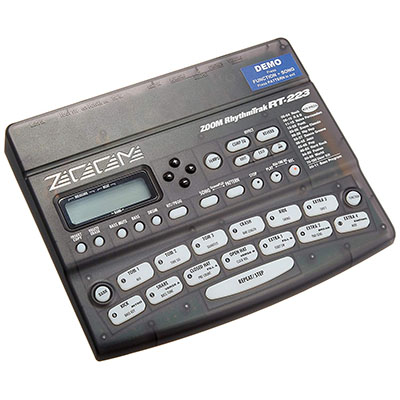
The Zoom RhythmTrak RT-223 Drum Machine is a basic drum machine that has several premium features that you only find in the more advanced and expensive drum machines on the market. The diversity of pre-loaded sounds is very good, and overall, the cost is also very reasonable, especially based on the features the machine comes with.
The Pros
- Has 500 pre-loaded drum sounds and an additional 70 drum kit beats
- Offers easy playability
- Comes with over 440 rhythmic patterns and 13 pads for a variety
- Durable
- The old-school design may appeal to those who want a vintage look
The Cons
- The layout of pads is somewhat unorthodox, which might be an issue with some players
- While the sound quality is good, it's's nowhere near that of the machine's competitors
The Verdict
The only shortcoming of the Zoom RhythmTrak RT-223 Drum Machine is definitely with the sound. If it is indeed going to compete with other brands in this regard, it has to improve a little bit. However, other than that, it is a basic and innovatively designed drum machine that offers better sound options in terms of diversity and range. Additionally, the Zoom RhythmTrak RT-223 Drum Machine is also easy to play and would be perfect for practice. In case you're looking for something cheap that still gives you value, do take a further look into this model.
Boss DR-880 Dr. Rhythm Drum Machine Review
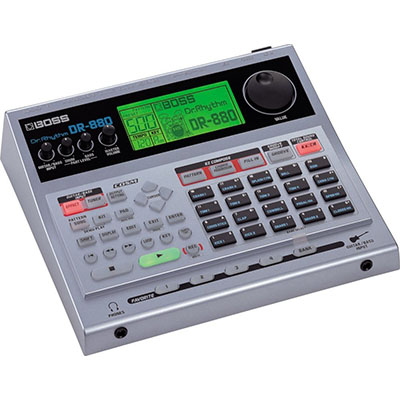
The Boss Dr. Rhythm DR-880 Rhythm Machine has become the drum machine of choice for bands on the road basically because of its portability and advanced features, including 880 pre-loaded drum sounds as well as some multi-effects. The machine also features a built-in COSM drive and input jack for the guitar.
The Boss DR-880 Dr. Rythm is a compact drum machine, designed for live use. Boss proudly advertises it's EZ-Compose mode, a utility that lets you quickly and easily program patterns. The 880 includes a spread of features, including 20 velocity-sensitive pads, four assignable footswitch and expression pedal inputs, guitar and bass inputs with effects, MIDI in/out, digital out, and a USB connector.
I, like many, found that the unit has a steep learning curve. With its impressive feature set, I wasn't surprised by this and dedicated an afternoon to learning the ins and outs. Once I got to know it, I was richly rewarded. Using a combination of my patterns, a few of the included 500 presets, and the EZ-Compose mode, I was able to get great results.
It easily handled guitar and bass riffs, making it a fantastic choice for the instrumentally-challenged groups out there. If, however, you're so inclined, the guitar and bass inputs are great for jamming along. In live and practice environments, the DR-880 shines, but the minute you step into a studio, it's darker side comes out.
Many of the snares lack brightness, especially against the cymbal samples. The bass is full, but the trebles can be obnoxiously present and overpowering. While we're on the topic of the 880's faults, it's worth mentioning that some users have filled the memory after as little as three sessions, versus Boss' advertised total of 500.
The Pros
- Wide range of drum sounds
- Offers innovative features to create your rhythms
- Remarkable built-in drum sound effects
- Very easy to program
The Cons
- Expensive
- Not simple enough for beginners
The Verdict
Overall, I would recommend the DR-880 to musicians looking for something to take to a gig. Its plastic casing feels sturdy; it has a great feature set, and can easily back up most styles. However, those seeking something to record with should look elsewhere.
The Usefulness Of Drum Machines
Musicians used to need to be part of an orchestra or band to create all the sounds they wanted to in a particular piece. But of course, a collection of musicians is an expensive endeavor. What happened in the twentieth century to change this?
One of the big innovations was the synthesizer, a keyboard that could shave expenses by making the sounds of piano, organ, or other instruments.
There was also the drum machine. A drum machine is a kind of synthesizer used to replicate drumming and other kinds of percussion. These kinds of sound machines have revolutionized the musical world.
Not only can expenses be cut, but more control is given to an individual musician who wants to make a particular impact. Artistic control is a coveted asset. In the 1930's, "rhythm machines" were the drum machines of their day. One of the earliest, the Rhythmicon, could produce 16 different sounds in different pitches.
These could be played alone or together. But somehow, perhaps because it was the era of the big band, these did not catch on with musicians. The only thing that did catch on was the use of the rhythm machines to preprogram set cadences, such as those with a Latin beat. In the 1950's and 1960's, another version was created by the Wurlitzer Company to accompany their organs.
This was called the Sideman, and it continued to be used in conjunction with organ music for some years, helping the organist to produce a rich, full sound in any piece or song. There's something about good percussion that makes music memorable, and the drum machine could allow that to happen without having to hire a drummer/percussionist.
But it wasn't until 1970, when "Somebody's Watching You" was covered by Little Sister that it's usefulness in pop tunes was recognized. The drum machine that highlighted the melody convinced musicians that it could enhance sound for the contemporary ear. A strong drumbeat became a necessary part of contemporary music, one that often made parents in the late 60's and '70's cringe.
From that time on, the use of drum machines became standard, at least for a while. Drum machines and synthesizers evolved in the computer age. While in the beginning years, their technology was analog; in later years, digital technology refined the sound. Of course, while for some purposes, this evolution is positive; for others, it is not.
The sound may be clearer, crisper, and more precise, but some artists like to find and use old machines so that they get the retro sound they're looking for. In the past few years, there's been less use of drum machines.
The computer age is with us and has certainly affected the music world. Sounds can easily be recreated by young people in their rooms using hardware samplers, music workstations where the drum sounds are integrated and sequenced, and special software for sequencing and sampling.
Background Of Drum Machines
Drum machines are machines that simulate the sounds of percussion instruments, most notably drums. They are useful and widely used electronic instruments, not only in the electronic music genre, but in many other genres as well, and they are perfect replacements for drummers when a session drummer cannot be found.
These machines offer a wide selection of drum lines, carefully and thoroughly sampled to be able to reproduce as closely as possible the original sound. They can also be adjusted by the users to suit personal inclinations, using the meticulously mapped out controls, allowing for a range of experimentation with the sound.
Drum machines were first available for commercial sale in the 1960s as a part of organs and were originally designed to accompany the organist as he played. These early machines were named rhythm machines.
The first successful one was called the Rhythm Ace, manufactured by a company called Ace Tone, whose name was later changed to Roland. Other rhythm machines from the 60s include the Rhythm Synthesizer, constructed by Raymond Scott in 1960, and the Bongo Artist, made by a company called Bandito.
These machines were sequencers that have a sample playback or synthesizer component that allows the machine to reproduce drum timbres, in addition to other classic percussion sounds. The early machines, due to their technology, did not always approximate the sound of the real instrument.
They used analog synthesizers rather than digital sampling, which is what is used today. A snare drum sound, for example, would be simulated by a burst of white noise, while a bass drum was created using basic waveforms, such as a sine wave. Modern-day machines use many precise controls to get the exact sound the user is looking for.
These controls include start and stop, tempo, controlling the volume for specific sounds, keys to choose individual drum sounds, and memory to store a variety of programmed rhythms. The majority of drum machines can be controlled through MIDI. It is also possible, through MIDI, or by pickups or trigger pads, to generate specific percussion sound modules.
Another aspect of the second by second control is that the drums can be programmed in real-time, allowing the user to determine the precise second a beat will sound. In 1980 the Linn LM-1 Drum Computer was created, the first one to use digital sampling. Most of the drum sounds were composed of dual chips, which were made at the same time. Each sound was separately tunable with individual outputs, but because of memory limitations, the cymbal sound could not be added.
Drum machines allow an artist to program-specific drum lines and store them, a skill which has become almost indispensable for drummers. These machines are now widely used in pop and rock concerts, due to their ability to create and retain in their memory unique drum lines.
Conclusion
The diversity of drum machines on the market today is exceptional, but even then, some brands have simply set themselves apart by offering superior features. If you are looking for a top-quality drum machine, the Boss Dr. Rhythm DR-880 Rhythm Machine and the Akai Professional XR20 Beat Production Station Drum Machine are some of the major options you can explore. The Boss loses points for how expensive it is, but these machines are both very nice in terms of sound quality. As for people who want a cheap design that still works well, the Alesis SR16 Drum Machine is indeed the best pick based on its layout and performance.
Last Updated: 21st Jan, 2025
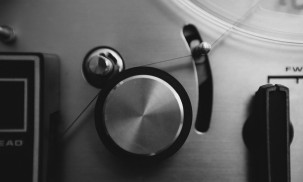
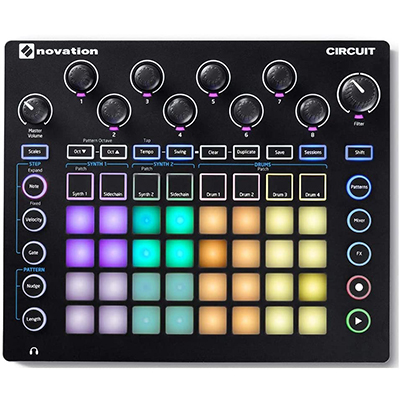
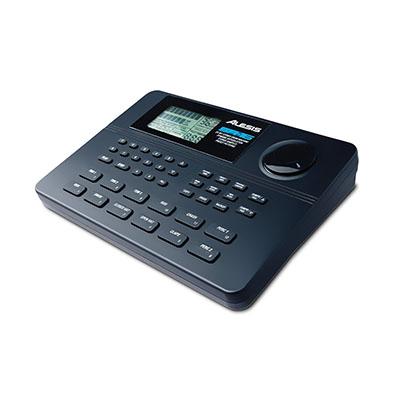

Comments
Leave the first comment